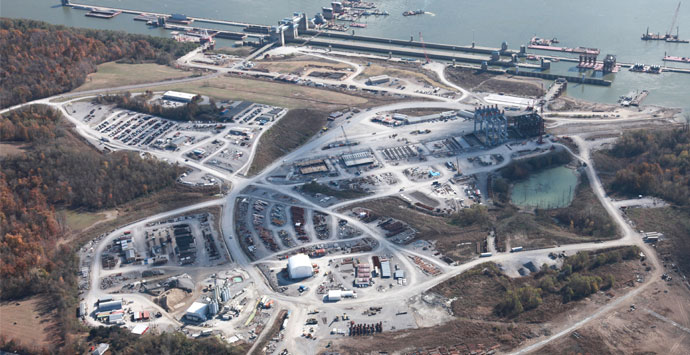#WomenExcel: Making it happen at the Olmsted Dam
The theme for International Women’s Day this year is “Make it happen.” As a productivity engineer at the Olmsted Dam project in the United States, I am constantly asking myself two major questions, “How can we improve?” and “How do I make it happen?”
I am always looking for ways to improve the quality of planning, collaboration and communication — three aspects that are essential when building a dam “in the wet,” which means that, during construction, the river is not being diverted away from the planned dam site. In the overall process, the pieces or shells that make up the dam are produced on land near the river, picked up by a Super Gantry Crane, placed on a cradle, then lowered into the river. The Catamaran Barge then picks up and transports the shells to their intended position in the river, and lowers them onto the prepared foundation. The shells are set in place with tremie concrete that is pumped through the lifting frame legs to fill the void under the shell and cement it to the foundation piles. Due to the complexity of this project, my role as a productivity engineer is crucial to ensuring excellence on the project.
 Natani Gourneau on top of the catamaran barge overlooking the Olmsted Locks project site.
Natani Gourneau on top of the catamaran barge overlooking the Olmsted Locks project site.
One way I help to make it happen is by leading a team that focuses on productivity, which we call Operation Dam Excellence (ODE). We share a common goal — successful completion of the Olmsted Dam. The team’s capacities include casting yard operations, heavy lift operations and marine operations. The ODE team represents a diverse range of people, including safety personnel, management, field workers, engineers, superintendents, office staff and foremen — all of which are focused on separate but integrated parts of the project. As a facilitator of ODE, a major aspect of what I do at the Olmsted Dam is to ensure all of these people come together to make the plan happen. I conduct the daily 8 a.m. team meetings, where we discuss each operation’s scope of work for the day, shared resources, shared work areas and whether the goals from the previous day’s work were met and if not, why not. This daily meeting is just one tool that I use to make sure that work is completed safely, efficiently, and as cost effectively as possible.
 Olmsted Dam project site.
Olmsted Dam project site.
With all things that include such a wide array of people and aspects of work, come challenges. Of all the challenges that I have come to deal with, the most interesting has to be creating an environment for collaboration, transparent communication and effective planning. As an engineer, I knew I needed to be prepared for the technical aspects of the work, but when working with people, you need more people skills. Fortunately, my “emotion-reading skills” make me very valuable to effective team situations. This is a trait that most women tend to carry and has come to help me in many professional situations. My sense of intuition and ability to “mind read” has helped me more than I could have ever thought possible.
 Olmsted casting yard, super gantry and catamaran barge.
Olmsted casting yard, super gantry and catamaran barge.
In fact, I recently came across an article from the New York Times that supported this same aspect. The article titled, “Why some teams are smarter than others,” states that a distinguishing characteristic of the smartest teams is that “teams with more women outperformed teams with more men. Indeed, it appeared that it was not ‘diversity’ (having equal numbers of men and women) that mattered for a team’s intelligence, but simply having more women…partly explained by the fact that women, on average, were better at ‘mindreading’ than men.” This skill has helped me to value each team member’s input and lead meetings in a forward direction.
 Olmsted Dam project site, including piers and first Tainter Gate.
Olmsted Dam project site, including piers and first Tainter Gate.
Therefore, I celebrate my learned skills and my innate abilities to help “make it happen.” I am very proud to be an engineer at the Olmsted Dam project and the fact that what I do on a daily basis makes a difference on the project is extremely rewarding. I feel that it is imperative to have more women on construction sites and in the industry due to the specialized skills that they bring with them. Every chance I get, I encourage the younger generation of women to do what challenges them and ensure that they understand that there are no boundaries to what they can do to make it happen!
Comment below to share how you “make it happen” at work! Be sure to use the #WomenExcel hashtag when you share this post on Twitter, Google+ or Facebook.
 Natani Gourneau, productivity engineer/construction engineer II at the Olmsted Dam Project, has been with AECOM for five years, including multiple estimating internships. She is a Boise State University alum who studied construction management with a minor in business. She also enjoys the company of her family and friends, spending time outdoors, exercising, listening to music, traveling and attending events.
Natani Gourneau, productivity engineer/construction engineer II at the Olmsted Dam Project, has been with AECOM for five years, including multiple estimating internships. She is a Boise State University alum who studied construction management with a minor in business. She also enjoys the company of her family and friends, spending time outdoors, exercising, listening to music, traveling and attending events.
LinkedIn: Natani Gourneau






